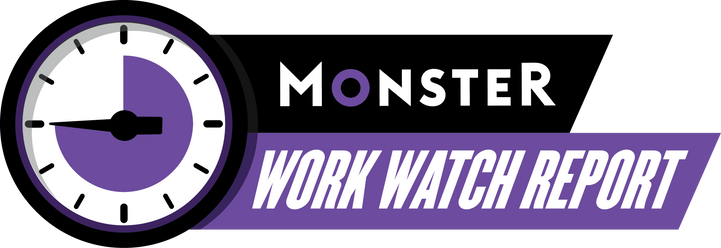Introduction
As the workforce continues to evolve, Monster looks back on another year of shifts for workers and employers alike. Staying on top of the latest workplace trends, Monster polled U.S. workers throughout the year to get their feedback on the most significant changes and factors that impacted the workforce. These findings and data were analyzed, along with our annual Future of Work Survey, to inform the 2024 edition of the Monster Work Watch Report.


A Message From Our CEO
The last year has been defined by the rise of AI, recession concerns, inflation, the Israel-Hamas conflict, Hawaiian wildfires, the persisting Ukraine war and more. Despite all of these significant events, the U.S. economy stubbornly avoided a recession. However, the increased cost of living impacted the workforce in major ways through staffing shortages, layoffs, employee burnout and more.
Following years of changes in the workforce as a result of the COVID-19 pandemic and other contributing factors, the world continued its path back to normalcy and the workforce followed. Forty-six percent of workers are back in the office full time, even though a flexible work model is the second most sought-after work benefit. As inflation continues to impact the cost of living for workers, 46% expect higher wages. At the same time, employers are on the hunt for talent, but 56% say finding the right candidates will become more difficult in the next three years.

Scott Gutz
CEO of Monster

Despite economic concerns and skepticism, the state of 2024 recruiting is showing no indications of slowing down. Workers will be happy to know, 64% of recruiters will continue to hire/fill roles as expected, with only 2% anticipating layoffs and/or furloughs in 2024. Additionally, half (51%) of employers are expecting their recruitment dollars to go up, further easing workers’ worries that employers may be pulling back on hiring.
We witnessed a new technology take the world by storm and it’s one that has great implications for the future of the workforce. For the first time, Artificial Intelligence (AI) is a resource that became widely available to employees and employers. Despite its accessibility, less than half (49%) of workers have used ChatGPT or a different AI generator for work. As this technology continues to advance, it remains to be seen how the workforce evolves with it.
The Monster Work Watch Team is proud to present the 2024 edition of the report to provide a deeper look into workforce trends, predictions, worker sentiment and much more.
Key Takeaways

Workers have wandering eyes
95% of workers are looking for or plan to look for a new job in 2024.
Salary expectations
In the current state of the economy, 81% of workers say their current wage has not kept up with the rising cost of living. On the other hand, 34% of employers say that workers’ salary expectations are higher and it is putting strain on their bottom line.
Adding fuel to the burnout fire
For many workers, this year was particularly exhausting. 75% of workers feel burnt out as a result of staffing shortages impacting their workloads. Staffing shortages may be slowing down, as only 2% of recruiters anticipate layoffs and/or furloughs.
Flexible work hours are vital
Workers agreed that more flexible work hours is the most important benefit in terms of supporting mental health/work well-being (29%). Employers continue to try to meet worker expectations, as 51% know offering flexible work options gives them a recruiting advantage.
The great return to office
Are workers migrating back to in-office work? 46% of American workers are back working in the office full time, compared to only 12% of workers that fulfill their role fully remote.
Skills and tools
Despite access to career advancement resources and new technologies, workers aren’t necessarily taking advantage of the tools at their disposal. Employers plan to capitalize on the benefits of AI.
Is DE&I still mandatory?
Nearly 3/4 (74%) of workers would still apply to a position at a company that doesn't have significant diversity, equity, and inclusion policies and initiatives in place. However, employers continue to prioritize DE&I efforts.

Job Hunt
Despite high employment for Americans, workers are constantly looking for their next opportunity, especially after negative work experiences at their current employer.

- 95% of workers are looking for or plan to look for a new job in 2024. [1]
- Though 96% of workers reported in January 2023 they were looking for a new job, in June of 2023 only 32% of workers reported having started a new role. [2]
- 83% of workers have experienced a negative employment situation this year, either remaining unemployed (32%) or seeing their salary or position negatively impacted (51%) in 2023. [2]
- 26% of workers said their company was directly affected by layoffs in the past year. Of the 7% of workers who were laid off this year, 4% were able to find a new position.

The recruitment process can be long and tedious for workers looking for their next role. Workers identified the top reasons or factors that would cause them to voluntarily pull out of the recruitment process.


- 47% said poor communication from the company, such as not being updated on their application status or their messages not being responded to quickly, if at all.
- 46% said the interviewer‘s attitude or behavior and 43% noted their recruiter‘s attitude or behavior.
- 36% agreed that being made to jump through hoops would make them pull out of the process.

- Employers’ top priorities in 2024 are to improve the success rate on hard-to-fill roles (43%) and to reduce the time to hire/fill positions (18%).
- Despite economic factors, 64% of recruiters will continue to hire/fill roles as expected, with only 2% anticipating layoffs and/or furloughs.
- 51% of employers expect their recruitment dollars to go up, while only 9% expect their recruitment budget to decrease.
- In 2024, 57% of recruiters’ strategies will shift their focus to retention over acquisition. Another 26% will focus less on strategic diversity hires and more on simply filling positions.
According to recruiters, the most important soft skills they are searching for from candidates are:
- Communication (39%)
- Problem-solving/critical thinking (25%)
- Teamwork/collaboration (8%)

Source: All data in this report comes from the Monster 2024 Future of Work Survey, conducted among US workers and HR professionals in September/October 2023, unless otherwise indicated. Sourced data comes from Monster’s bi-weekly polls of US workers, conducted among workers in 2023-24: 1) New Year, New Career, January 2024; 2) Mid-Year Check-In, June 2023.

Work Well-Being

Workers continue to strive to maintain healthy work-life balances, however, layoffs and staffing shortages impacted this ambition.

- 75% of workers feel burnt out as a result of staffing shortages impacting their workloads this year.
- Amid widespread staffing shortages across industries, 55% of workers said their company has been impacted by staffing shortages, with 24% experiencing a significant increase in their workload as a result.
- 23% reported feeling more burnout than ever and 26% noted that their level of burnout has increased significantly.
- Workplaces can also have a significant impact on the mental health of workers, with 63% saying their mental health at work is poor (35%) or fair (28%) and another 63% feeling that they work in a toxic environment. [1]
- 75% of workers don’t think their employer is doing enough to address their mental wellness at work. [1]
- 57% of workers would rather quit and 32% would rather get laid off from their job than work in a toxic workplace. [1]
Source: All data in this report comes from the Monster 2024 Future of Work Survey, conducted among US workers and HR professionals in September/October 2023, unless otherwise indicated. Sourced data comes from Monster’s bi-weekly polls of US workers, conducted among workers in 2023-24: 1) Mental Health In The Workplace, April 2023.

Benefits
Employee benefits continue to become more important to workers’ job selection and retention. Employers continue to offer a range of benefits for their workers including health and wellness, time off, financial benefits and more.


- Workers agreed that more flexible work hours is the most important benefit in terms of supporting mental health/work well-being (29%). Other top benefits included:
- More remote work flexibility (22%)
- Fitness stipends, mental health services, paid learning opportunities, and career education allowance (21%)
- More paid vacation time (20%)
- 42% of workers shared that a salary increase would be the most attractive benefit to them, followed by increased remote work flexibility, according to 16% of workers.

- Only 8% of workers felt a promotion would be the most attractive benefit, with the same percentage of workers reporting unlimited paid time off would be the most attractive benefit.
- 66% of workers are not offered any Summer Benefits by their employer. [1]
- 63% of workers would rather have a raise in lieu of all Summer Benefits, with 42% craving increased remote work flexibility. [1]
- 36% of employers shared that employees expect to have these benefits in place, but in practice most are not utilizing them. However, the same percentage (36%) also believe that most employees are taking advantage of their benefits.
- 47% of employers plan to increase their benefits/employee perks to remain competitive in hiring.
- To meet workers’ demand for benefits, employers are increasing:
- Paid time off, including paid volunteering days and self-care days (37%)
- Healthcare benefits (27%)
- Remote flexibility (10%)

Source: All data in this report comes from the Monster 2024 Future of Work Survey, conducted among US workers and HR professionals in September/October 2023, unless otherwise indicated. Sourced data comes from Monster’s bi-weekly polls of US workers, conducted among workers in 2023-24: 1) Summer Benefits, June 2023.

DE&I
Most workers have experienced some form of discrimination in the workplace, highlighting the importance for employers to continue fostering inclusive, equal and accepting environments for their workers. However, not having DE&I policies in place isn’t a dealbreaker for most workers.


- Nearly 3/4 (74%) of workers would still apply to a position at a company that doesn't have significant diversity, equity and inclusion (DE&I) policies and initiatives in place.
- Only 26% of workers would refrain from applying to such a position.
- Only 9% of workers say they haven’t experienced discrimination in the workplace. [1]
- 77% of workers have witnessed an act of workplace discrimination, yet 28% of workers don’t feel comfortable reporting an incident. [1]
- 50% of workers say they’ve experienced discrimination in the job application process based on age, with 40% experiencing discrimination in the job application process based on race. [1]
- Only 15% of workers have not experienced a form of pay inequality. [2]
- 76% of workers report that their organization does not have a LGBTQ Employee Resource Group or support group [3]

- 25% of recruiters feel that ensuring diversity and inclusion in the hiring process will become increasingly difficult in the next three years, while 24% are increasing their overall Diversity, Equity and Inclusion efforts to remain competitive in hiring.
- 28% of employers are focusing on diversity and inclusion in the hiring process to ensure their workers have a broad range of skills and perspectives.

Source: All data in this report comes from the Monster 2024 Future of Work Survey, conducted among US workers and HR professionals in September/October 2023, unless otherwise indicated. Sourced data comes from Monster’s bi-weekly polls of US workers, conducted among workers in 2023-24: 1) Workplace Discrimination, July 2023; 2) Equal Pay, September 2023; 3) LGBTQ Identity in the Workplace, May 2023.

Salary & Expectations
With inflation impacting all workers at every level in 2023, salary remains extremely important to them. Workers were and are looking for increased pay to combat higher living expenses, while employers try to keep up with expectations.


- Of the 46% of workers who said their salary expectations are higher than last year, 82% noted increased cost of living as the primary reason, while 37% expect an increase in salary due to them taking on more responsibility in their role.
- 81% say their current wage has not kept up with the rising cost of living. [1]
- 75% are more mindful of their spending for basic needs like rent and groceries due to inflation and the rising cost of living. [1]
- 77% say their employers have not offered any additional benefits to keep up with inflation and the cost of living. [1]

- With workers expecting increased salaries, 59% of employers plan to offer increased salary and wages to remain competitive in hiring.

Source: All data in this report comes from the Monster 2024 Future of Work Survey, conducted among US workers and HR professionals in September/October 2023, unless otherwise indicated. Sourced data comes from Monster’s bi-weekly polls of US workers, conducted among workers in 2023-24: 1) Wages and the Cost of Living, April 2023).

Work Environment
Similar to recent years, remote work and more flexible work environments continue to be one of the most desirable benefits. However, there is a disconnect between the amount of workers who want the ability to work remotely and those who receive that flexibility.


- Are workers migrating back to in-office work? 46% of American workers are back working in the office full time, compared to only 12% of workers who fulfill their role fully remote.
- During the job application process however, 35% of workers would refrain from applying to a position that required them to work fully in-person (5 days a week). Nearly half of all workers however (47%), would still apply to a position regardless of the in-office or remote requirement.
- 24% have lied to their manager or team about a family emergency or other obligation to take time off of work or to work remotely for pleasure [1]
- 23% admit that taking a workcation would decrease their work productivity or make the quality and quantity of their work suffer. [1]
- 61% of workers want a four-day work week, rather than a traditional five-day week. [1]

- As 33% of employers admitted that finding talent to work in-person/on-site will become increasingly difficult in the near future, 36% of employers are changing their roles to become more flexible/remote.
- Flexibility remains top of mind for employers as well. 51% of employers agree that candidates expect more flexibility in where they work compared to the prior year, and 34% candidates expect more flexibility in when they work compared to the prior year.
- Flexible work schedules and locations are beneficial to recruiters’ jobs:
- 51% say offering flexible work options gives them a recruiting advantage.
- 49% think flexible work options help them retain talent.
- 41% agree that hybrid work schedules are the way of the future.
- 36% think four-day work weeks are the way of the future.

Source: All data in this report comes from the Monster 2024 Future of Work Survey, conducted among US workers and HR professionals in September/October 2023, unless otherwise indicated. Sourced data comes from Monster’s bi-weekly polls of US workers, conducted among workers in 2023-24: 1) Work Productivity, March 2023.

Career Advancement & Tools
There is no shortage of skills and new technologies that can increase workers' value and productivity in their respective fields. However, the rate at which workers are pursuing these advancements may not be as high as one might think.


- 70% of workers have not pursued any professional skill advancements through online courses, degrees, certifications etc., in the past year.
AIs like ChatGPT, are becoming one of the most common new tools for workers to utilize.
- 49% of workers have used ChatGPT or a different AI generator for work. [1]
- 68% of workers think they can perform core tasks of their job better than an AI generator. [1]

Recruiters plan to embrace the capabilities of AI for their ability to enhance and streamline the recruitment process.
- 31% of recruiters plan to increase their use of AI or similar technology during the recruitment process, while 40% think keeping up with AI and other technological advancements will increase the difficulty of their job.
- 40% of recruiters think AI streamlined the search process by identifying candidates with the right skills, faster.
- 36% of employers agree that AI helped write more compelling job descriptions and 26% agreed that AI chatbots improved candidate communication and engagement during the hiring process.
- 30% of employers are offering skills training to remain competitive in attracting talent.
- 39% also offer training and development programs to help employees develop necessary skills to advance in their careers.

Source: All data in this report comes from the Monster 2024 Future of Work Survey, conducted among US workers and HR professionals in September/October 2023, unless otherwise indicated. Sourced data comes from Monster’s bi-weekly polls of US workers, conducted among workers in 2023-24: 1) A.I. in the Workplace, February 2023.
2024 Predictions
Leaving behind a year defined in part by economic uncertainty, inflation, new tech tools, work models, and more, there is much to look forward to and be prepared for in 2024. As we look ahead, the 2024 Monster Work Watch report provides a greater understanding of what workers desire and how employers can meet their needs. The past few years have ushered in a new era of remote work, worker benefits, increased DE&I efforts and more. While these trends may persist, workers and employers will have to remain adaptable in the midst of inflation, staffing shortages, and new technologies such as AI. The calendar may change, but the Monster Work Watch team will remain vigilant in examining worker sentiment, uncovering trends and observing the continued workforce evolution.






Methodology
The 2024 Monster Work Watch Report was compiled from worker and manager data from Monster’s Future of Work survey conducted in November 2023. Research was conducted among recruiters/those involved in talent acquisition, HR and/or the recruitment industry and workers 18+ that are both employed or unemployed and in the job market. The survey was conducted by an independent research firm (Dynata). The 2024 Monster Work Watch Report also consists of data from Monster’s bi-weekly polls, fielded through third-party sources (Jebbit and SurveyMonkey), surveying American job seekers/workers.
Resources